at the end of the day
virginia baxter: maria fernanda cardoso, r e a, narelle autio
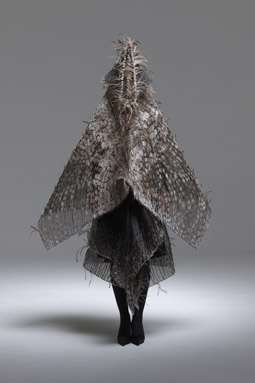
Ruana 2008, Lambda print on photographic paper, Emu Wear, Maria Fernanda Cardoso, GrantPirrie, Sydney
image courtesy GrantPirrie
Ruana 2008, Lambda print on photographic paper, Emu Wear, Maria Fernanda Cardoso, GrantPirrie, Sydney
THERE’S NOTHING QUITE LIKE A GALLERY CRAWL TO TAKE YOU OUT OF YOURSELF. ASSUMING MULTIPLE PERSPECTIVES OVER A SHORT SPACE OF TIME OPENS THE MIND TO ALL SORTS OF POSSIBILITIES.
Case in point. Who would have thought to take the components of an emu and reassemble them in a hybrid exhibition of sculpture, photography and exotic garments? Well, this idea has kept the ever-inventive Maria Fernanda Cardoso busy for a couple of years (2006-2008) and culminated in the surprising exhibition, Emu Wear at GrantPirrie Gallery in Redfern [p3].
Entering the gallery is like stumbling upon a sombre place of ritual or homage. At first you gaze in wonder at the garments on display, marvel at the immense variety of tone that exists within a palette of browns and greys. Then you’re struck by the sheer ingenuity of the artist’s intervention, the intricate weaving and shaping of variously sized and shaped feathers into capes, hoods, undergarments (!). Glamour glowers at the bird’s own mundane appearance. Unsettling sensations creep in. An eviscerated emu appears on a plinth, elsewhere a pair of preserved feet and legs hang from the ceiling, others are fashioned into the shape of boomerangs. Thoughts of the birds’ demise niggle. The large, stately photographs on the wall are telling. As if standing in for the artist, serious young models invoke a blend of faux indigeneity, ironic fashion statement and something else besides. Enveloped in the plumage of this ancient creature, they gaze inward or peer out at us from the other side.
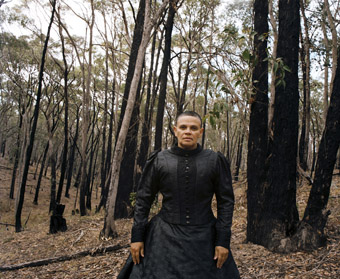
from triptych PolesApart3, 2009; c-type photograph, r e a, BreenSpace, Sydney.
images courtesy of the artist
from triptych PolesApart3, 2009; c-type photograph, r e a, BreenSpace, Sydney.
For different reasons, the same unsettling sensation is sustained at BreenSpace in media artist r e a’s PolesApart. Again, we enter a room of large photographs. Though it’s small, we might be in a gallery of McCubbin’s and Streeton’s. In this series of commanding triptychs, a narrative unfolds. Amidst a burned bush landscape, the artist appears wearing a black crinoline that might suggest mourning or service, perhaps both. Her hair close cropped, feet hidden beneath the dress, she flees from an unseen pursuer, glancing around her as if threatened from all directions. In one image she sinks to the ground, her dress ballooning around her. In another she hovers uncertain behind a tree. A small but imposing figure, she is dwarfed by and sometimes disappears altogether amidst the bleak grandeur of blackened tree trunks. In the adjacent darkened room, a video projected onto one wall completes the narrative suggested in the still frames. As the artist runs through the trees, moving furtively into frame, she is violently doused in red, white and blue paint by her unseen antagonists.
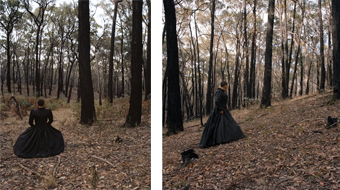
panels 1 and 3 from triptych PolesApart 2, 2009; c-type photographs, r e a, BreenSpace, Sydney
images courtesy the artist
panels 1 and 3 from triptych PolesApart 2, 2009; c-type photographs, r e a, BreenSpace, Sydney
The detailed exhibition notes by Dr Christine Nicholls discuss the work’s many references, in particular the experience of the artist’s grandmother and great aunt who were both stolen from their families in 1916 to be trained as maidservants. One escaped from servitude and returned home, the other worked for a time as the personal servant to Dame Nellie Melba and never again found her family. The choice of Daylesford in Victoria as the location for the images connects with the artist’s underlying research into the Heidelberg artists who worked nearby but “simply did not see the Indigenous presence in that country—Indigenous people were invisible to them.”
The artist takes colonial and art history, personal memory, painful lived experience and distils them into a powerful exhibition, which expresses the frustration and anxiety of living in a country that refuses to truly acknowledge its indigenous history and heritage.
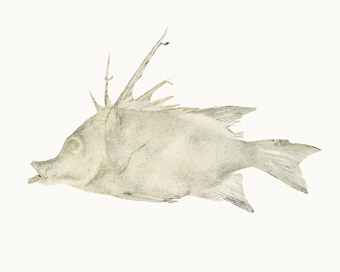
from The Summer of Us, Narelle Autio
courtesy the artist and Stills Gallery
from The Summer of Us, Narelle Autio
Finally when my visual appetite is almost sated, Narelle Autio’s The Summer of Us at Stills Gallery revives the senses. Once again, this photographer whose element is the sea, displays her serious regard for its power and poetry. The gallery is ablaze, white walls displaying a multitude of coloured objects photographed against more shiny white. Gathered by the photographer over one summer from beaches near her home in Adelaide, an accumulation of objects appears at first a taxonomy of refuse. Autio has transferred flotsam and jetsam to her studio and photographed each item in loving detail, using large format film and a light table. Retaining the patina of its age, the depth of detail in its edges and crevices, she turns each piece of trash into a glowing treasure.
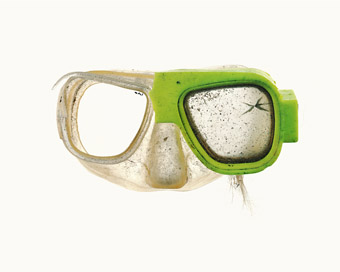
from The Summer of Us, Narelle Autio
courtesy the artist and Stills Gallery
from The Summer of Us, Narelle Autio
Beyond the glare, the pleasures of profusion, the delicate detail enhanced by the photographic process, vision floats. The room becomes a mind or a memory in which you venture connections. Clothing, bottles, toys, tyres, technology’s tacky remains are all in a process of conversion and disappearance. You observe the subtle shifts of nature (fish to sand sculpture, glove to flowering seaweed) whether converting its own familiar materials or appropriating humanity’s remnants. Noble in death, the corpses of birds and fish are preserved in salt and sand. Art approaches science. Autio, curator of everyday spectacle, lays out her evidence in multiples—comparing shark eggs, crab claws, anemone shells, fishing lures. There’s so much to see here that, my head swimming, I have to be dragged away.
At the end of the day, as they say, after this series of shape-shifting experiences, there’s an uncanny sense of resonance and a strange kind of coherence. Historical, zoological, political, personal and anthropological merge in what has been an unexpectedly magical mystery tour.
Maria Fernanda Cardoso, Emu Wear GrantPirrie, Redfern, April 30- May 23; r e a PolesApart, BreenSpace, Waterloo, April 3-May 2: creative team: co-ordinator/director Gail Kelly; designer Amanda Fairbanks; photographic/technical Cathy Laudenbach; camera/editor Peter Oldham; video shoot Assistant Sumai McLean; Narelle Autio, The Summer of Us, Stills Gallery, Sydney, March 25-May 9
RealTime issue #91 June-July 2009 pg. 54






